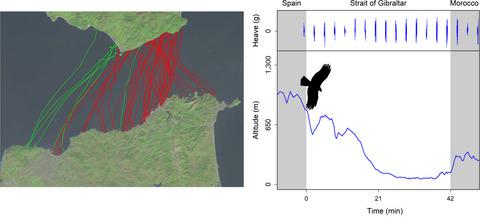当前位置:
X-MOL 学术
›
J. Anim. Ecol.
›
论文详情
Our official English website, www.x-mol.net, welcomes your
feedback! (Note: you will need to create a separate account there.)
The gateway to Africa: what determines sea crossing performance of a migratory soaring bird at the strait of Gibraltar?
Journal of Animal Ecology ( IF 3.5 ) Pub Date : 2020-04-01 , DOI: 10.1111/1365-2656.13201 Carlos David Santos 1, 2 , João Paulo Silva 3, 4 , Antonio-Román Muñoz 5 , Alejandro Onrubia 6 , Martin Wikelski 2, 7
Journal of Animal Ecology ( IF 3.5 ) Pub Date : 2020-04-01 , DOI: 10.1111/1365-2656.13201 Carlos David Santos 1, 2 , João Paulo Silva 3, 4 , Antonio-Román Muñoz 5 , Alejandro Onrubia 6 , Martin Wikelski 2, 7
Affiliation

|
Large bodies of water represent major obstacles for the migration of soaring birds because thermal updrafts are absent or weak over water. Soaring birds are known to time their water crossings with favourable weather conditions and there are records of birds falling into the water and drowning in large numbers. However, it is still unclear how environmental factors, individual traits and trajectory choices affect their water crossing performance, this being important to understand the fitness consequences of water barriers for this group of birds. We addressed this problem using the black kite (Milvus migrans) as model species at a major migration bottleneck, the Strait of Gibraltar. We recorded high-resolution GPS and triaxial accelerometer data for 73 birds while crossing the Strait of Gibraltar, allowing the determination of sea crossing duration, length, altitude, speed and tortuosity, the flapping behaviour of birds and their failed crossing attempts. These parameters were modelled against wind speed and direction, time of the day, solar irradiance (proxy of thermal uplift), starting altitude and distance to Morocco, and age and sex of birds. We found that sea crossing performance of black kites is driven by their age, the wind conditions, the starting altitude and distance to Morocco. Young birds made longer sea crossings and reached lower altitude above the sea than adults. Crosswinds promoted longer sea crossings, with birds reaching lower altitudes and with higher flapping effort. Birds starting at lower altitudes were more likely to quit or made higher flapping effort to complete the crossing. The location where birds started the sea crossings impacted crossing distance and duration. We present evidence that explains why migrating soaring birds accumulate at sea passages during adverse weather conditions. Strong crosswinds during sea crossings force birds to extended flap-powered flight at low altitude, which may increase their chances of falling in the water. We also showed that juvenile birds assume more risks than adults. Finally, the way in which birds start the sea crossing is crucial for their success, particularly the starting altitude, which dictates how far birds can reach with reduced flapping effort.
中文翻译:

通往非洲的门户:是什么决定了直布罗陀海峡候鸟的跨海性能?
大水体是翱翔鸟类迁徙的主要障碍,因为没有热上升气流或在水面上的热气流很弱。众所周知,翱翔的鸟类会在有利的天气条件下为它们的水域安排时间,并且有大量鸟类落入水中淹死的记录。然而,目前尚不清楚环境因素、个体特征和轨迹选择如何影响它们的过水性能,这对于了解水屏障对这组鸟类的健康影响很重要。我们使用黑鸢(Milvus migrans)作为主要迁移瓶颈(直布罗陀海峡)的模型物种解决了这个问题。我们在穿越直布罗陀海峡时记录了 73 只鸟的高分辨率 GPS 和三轴加速度计数据,允许确定跨海持续时间、长度、高度、速度和曲折度、鸟类的扑翼行为及其失败的跨海尝试。这些参数根据风速和风向、一天中的时间、太阳辐照度(热上升的代表)、起始高度和到摩洛哥的距离以及鸟类的年龄和性别进行建模。我们发现黑风筝的跨海性能受其年龄、风力条件、起点高度和到摩洛哥的距离的影响。与成鸟相比,幼鸟跨越了更长的海路,到达的海拔高度更低。侧风促进了更长的海上穿越时间,鸟类到达较低的高度并增加了扑腾的力度。从低海拔开始的鸟类更有可能放弃或做出更大的扑翼努力来完成穿越。鸟类开始跨海的位置影响了跨海距离和持续时间。我们提供的证据解释了为什么在恶劣的天气条件下候鸟会在海上通道中聚集。过海期间的强侧风迫使鸟类在低空延长襟翼动力飞行,这可能会增加它们掉入水中的机会。我们还表明,幼鸟比成年鸟承担更多的风险。最后,鸟类开始穿越海洋的方式对其成功至关重要,尤其是起始高度,这决定了鸟类在减少拍打力的情况下可以到达多远。过海期间的强侧风迫使鸟类在低空延长襟翼动力飞行,这可能会增加它们掉入水中的机会。我们还表明,幼鸟比成年鸟承担更多的风险。最后,鸟类开始穿越海洋的方式对其成功至关重要,尤其是起始高度,这决定了鸟类在减少拍打力的情况下可以到达多远。过海期间的强侧风迫使鸟类在低空延长襟翼动力飞行,这可能会增加它们掉入水中的机会。我们还表明,幼鸟比成年鸟承担更多的风险。最后,鸟类开始穿越海洋的方式对其成功至关重要,尤其是起始高度,这决定了鸟类在减少拍打力的情况下可以到达多远。
更新日期:2020-04-01
中文翻译:

通往非洲的门户:是什么决定了直布罗陀海峡候鸟的跨海性能?
大水体是翱翔鸟类迁徙的主要障碍,因为没有热上升气流或在水面上的热气流很弱。众所周知,翱翔的鸟类会在有利的天气条件下为它们的水域安排时间,并且有大量鸟类落入水中淹死的记录。然而,目前尚不清楚环境因素、个体特征和轨迹选择如何影响它们的过水性能,这对于了解水屏障对这组鸟类的健康影响很重要。我们使用黑鸢(Milvus migrans)作为主要迁移瓶颈(直布罗陀海峡)的模型物种解决了这个问题。我们在穿越直布罗陀海峡时记录了 73 只鸟的高分辨率 GPS 和三轴加速度计数据,允许确定跨海持续时间、长度、高度、速度和曲折度、鸟类的扑翼行为及其失败的跨海尝试。这些参数根据风速和风向、一天中的时间、太阳辐照度(热上升的代表)、起始高度和到摩洛哥的距离以及鸟类的年龄和性别进行建模。我们发现黑风筝的跨海性能受其年龄、风力条件、起点高度和到摩洛哥的距离的影响。与成鸟相比,幼鸟跨越了更长的海路,到达的海拔高度更低。侧风促进了更长的海上穿越时间,鸟类到达较低的高度并增加了扑腾的力度。从低海拔开始的鸟类更有可能放弃或做出更大的扑翼努力来完成穿越。鸟类开始跨海的位置影响了跨海距离和持续时间。我们提供的证据解释了为什么在恶劣的天气条件下候鸟会在海上通道中聚集。过海期间的强侧风迫使鸟类在低空延长襟翼动力飞行,这可能会增加它们掉入水中的机会。我们还表明,幼鸟比成年鸟承担更多的风险。最后,鸟类开始穿越海洋的方式对其成功至关重要,尤其是起始高度,这决定了鸟类在减少拍打力的情况下可以到达多远。过海期间的强侧风迫使鸟类在低空延长襟翼动力飞行,这可能会增加它们掉入水中的机会。我们还表明,幼鸟比成年鸟承担更多的风险。最后,鸟类开始穿越海洋的方式对其成功至关重要,尤其是起始高度,这决定了鸟类在减少拍打力的情况下可以到达多远。过海期间的强侧风迫使鸟类在低空延长襟翼动力飞行,这可能会增加它们掉入水中的机会。我们还表明,幼鸟比成年鸟承担更多的风险。最后,鸟类开始穿越海洋的方式对其成功至关重要,尤其是起始高度,这决定了鸟类在减少拍打力的情况下可以到达多远。











































 京公网安备 11010802027423号
京公网安备 11010802027423号